Navajo Get-Away
Story and photography by Larry Greenbaum
Why am I, no longer officially an educator, writing on this site and sharing my images? The answer is simple – as a tribute to Jessie Voigts, the co-publisher. What Jessie does is done right and done thoroughly and done with consideration to each individual with whom she interacts, communicates, or does business. Jessie, I applaud you and Ed for creating Wandering Educators. I am pleased to offer this essay as a toast to you.
The days around Halloween 2008 offered my wife, Alice, and I a chance to sneak in a few days of remote Arizona travel prior to a meeting in Phoenix. Flagstaff, north about 120 miles on I-17 with a jog through Sedona and Oak Creek Canyon, provided an en-route place to relax after a long day of airports, jets, and driving.
The images I offer are for viewing pleasure and are all copyrighted. So, don’t copy them. They are available for purchase upon request at which time I will remove the large copyright text and offer a presentation print or electronic image with the understanding that it will not be reproduced or sold for any purpose without my permission. Thanks for agreeing to my ground rules.

Entering Sedona - a view from the visitor’s center. The autumn yellows of the foreground trees spoke to me as they complement the red sandstone and blue sky.

Red rocks at dusk
Backtrack 250 million years to the Triassic Period when North America was located close to the equator and Arizona was in the vicinity of present day Panama. The climate was warm and moist, and coniferous forests were plentiful along the plain that is now Northeastern Arizona. Over the millions of years, the remains of the trees turned to stone and the land was shaped by erosion into colorful badlands (that’s an oxymoron) that now occupy the Painted Desert .
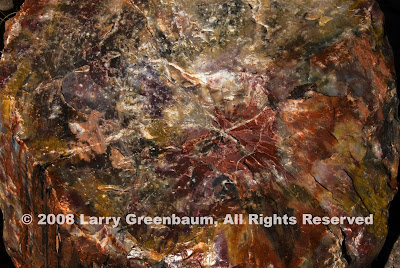
Cross section of a petrified log
The following two images are in the Blue Mesa area of the park. Teetering and fallen logs are strewn in the badlands. The textures, colors, shapes and striations of the land and rocks fascinate me.
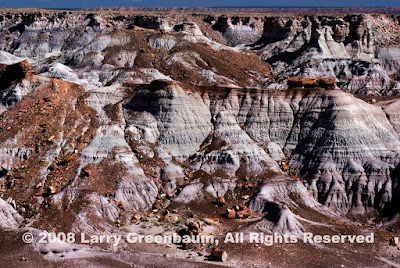

Light illuminates grasses and vegetation that abides in eroded rock.
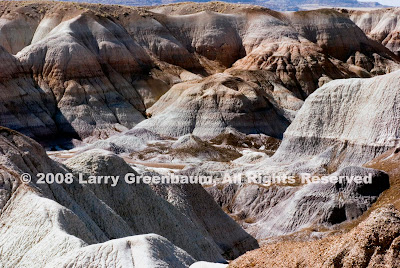
Domes and shapes of red, blue, brown, and gray decorate this eroded landscape.

For me, these droid-like statuaries, reminiscent of Star Wars’ R2D2 and Darth Vader, guard and frame the Painted Desert. Petrified Forest National Park has among the purest and cleanest air in the United States, according to park rangers.
Whenever I’m in the desert, I feel an immense sense of beauty in remoteness. The scale of nature gives us human visitors a message about the brief and tiny space we occupy, making it all more important that we strive for making a difference in our lives to those we love, to our communities, and to our world by respecting and conserving nature. Our brief stay in Chinle and Canyon De Chelly (pronounced “deh shay”) added the dimension of experiencing Navajo life and culture. Chinle is in Northeastern Arizona on the Navajo Reservation. Unfortunately, there was no time to spend a day in Window Rock, AZ – sixty-plus miles east – the capital of the Navajo Nation on the New Mexico border.
Canyon De Chelly is protected as a National Monument because of the many Anasazi ruins throughout the canyon. To see the ruins well, it is necessary to go into the canyon by truck or jeep with a Navajo tour guide. The tour provides an appreciation for the fact that the Navajo people live and farm inside the canyon. We visitors must appreciate and respect that we are visitors among the dineh (Navajo people). Out of respect to them, I do not have any images of Navajo people.
The Hubbell Trading Post in Ganado, AZ is a historic post that provided a means for the Navajo to market and sell their rugs.
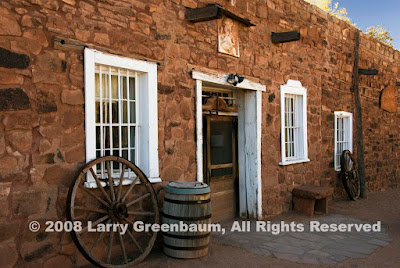
Hubbell Trading Post
My signature image of Canyon De Chelly is Spider Rock below. Navajo lore explains that it was the spider woman who taught the Navajo women to weave and spider man who taught the men to make the tools – loom, etc. – for weaving.
We arrived at Spider Rock overlook about 4:00 P.M. when there was a black shadow obscuring over half of the spider rock and the canyon. After discarding about 50 images, we waited until after 6:30 P.M. to take this image after the sun had completely set below the horizon.

Spider Rock Overlook

White House Ruin

White House Ruin – horizontal view
The drama of White House Ruin, named after the white walls in the ruin cave, is in the immensity of the cliff and the vertical varnish that looms over it, framing the image. There are several Anasazi (a Navajo word for the ancient ones) ruins in the Monument. There is little known about the Anasazi other than that they mysteriously vanished around the 13th century. Perhaps they are the first Pilgrims. We know that the Navajo are an Athabascan people who migrated from northern Alberta, Canada. Once in the southwest the Navajo adopted and adapted many of the ways of the Pueblo.
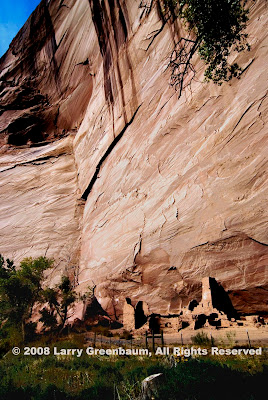
Antelope Ruin
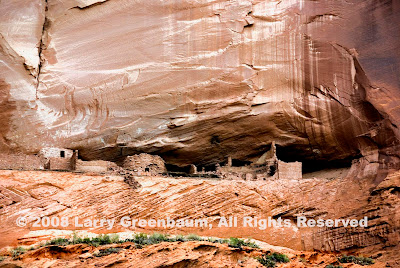
Junction Ruin above and below.
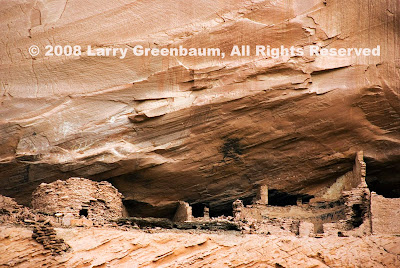
Canyon De Chelly (the Navajo name is something like “tze ei” meaning rock canyon). The Spanish who became dominant in the area in the 15th and 16th centuries called it ‘che ay,” hence De Chelly.
We found the continuity of life in the canyon awe inspiring (even after the U.S. military under Kit Carson brutally invaded the dineh (Navajo for people) living there.) The next image – depicts this generational continuity – a modern Navajo homestead beneath an ancient Anasazi ruin. Notice the cave on the upper left in the cliff.

Navajo Homestead
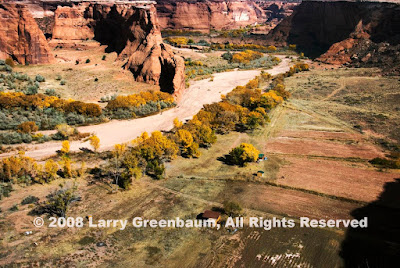
Navajo Farm – the wash on the canyon floor is the main thoroughfare for travel via four-wheel drive vehicle – some tourists ride horseback.
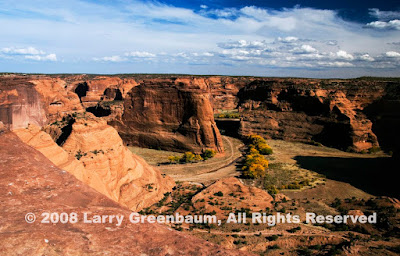
This lookout from White House trail offers a good view of the canyon and the high desert of Northeastern Arizona.

Sacred Cow Kiva is an ancient ruin (kivas were used for worship) that is used today by the Navajo as a summer shelter. Note the weaving loom at the right.
The modern door and window certainly complete the anachronism. Note the pictographs on the canyon wall.
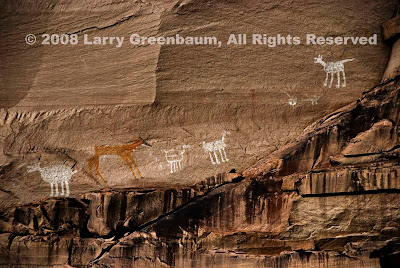
Man’s best friends
These pictographs illustrate the importance of animals in people’s lives. Pictographs are painted on the rock; petroglyphs are etched into the rock.
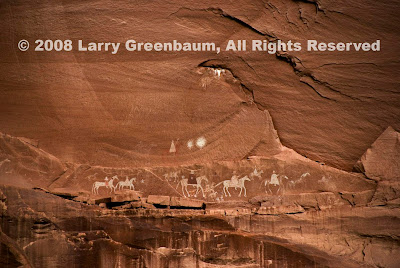
I call this Navajo Horsemen – what a stunning pictograph with which to close this story.
Thanks for reading and viewing Alice’s and my get-away for a few days in Navajo country.
1- Ash, Sidney, Petrified Forest, A Story in Stone, Petrified Forest Museum Association, 2005, pg. 8.
All photos courtesy and copyright of Larry Greenbaum.
